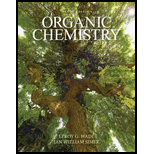
Concept explainers
(a)
Interpretation:
The boronic acid or boronate ester that is used in the Suzuki coupling reaction to make the given product is to be stated.
Concept introduction:
In the Suzuki coupling reaction, the palladium-catalyzed substitution occurs in which the coupling of an aryl or vinyl halide with an alkyl, alkenyl, or aryl boronic acid or boronate ester results in the formation of
(b)
Interpretation:
The boronic acid or boronate ester that is used in the Suzuki coupling reaction to make the given product is to be stated.
Concept introduction:
In the Suzuki coupling reaction, the palladium-catalyzed substitution occurs in which the coupling of an aryl or vinyl halide with an alkyl, alkenyl, or aryl boronic acid or boronate ester results in the formation of alkane, boric acid and sodium halide.
Want to see the full answer?
Check out a sample textbook solution
Chapter 17 Solutions
Organic Chemistry (9th Edition)
- Predict the product or provide reagents needed to complete each transformation.arrow_forwardThe reaction of an alkene with diazomethane forms a cyclopropane ring. Propose a mechanism for the reaction.arrow_forwardShow how to synthesize 3-nitro-4-propoxybenzoic acid from phenol, C6H5OH and any reagents that you need.arrow_forward
- complete the following synthesesarrow_forwardSynthesis . Show how you would carry out the following transformations. You may use any solvents, organic and/or inorganic reagents. A mechanism is not necessary but you must provide the correct products for each step.arrow_forwardSynthesize the product shown from the starting materials, including intermediates formed at each steparrow_forward
- The following synthesis requires more than one step. Specify the reagents you would use to carry it out.arrow_forwardSynthesize the products shown below starting from the reactants provided and using any other necessary reagents. Clearly draw out all reagents and intermediates on the pathway to the product.arrow_forwardUsing the compounds below, synthesize the resulting product using the appropriate reaction steps.arrow_forward
- Synthesize the following compounds from the given starting material. You can add on any alkyl/ alkyl halide under 8 carbons or any necessary inorganic reagent needed (this includes triphenyl phosphine (Ph3P). Please draw all intermediates and reagents necessary to get to the productarrow_forwardPropose a synthesis for each product.arrow_forwardyou are performing an acyl nucleophilic substitution reaction using sodium acetate, acetic anhydride, salicyclic acid, and pyridine. show a mechanism for the reaction, and label the nucleophile, acyl compound, and the catalyst.arrow_forward
 ChemistryChemistryISBN:9781305957404Author:Steven S. Zumdahl, Susan A. Zumdahl, Donald J. DeCostePublisher:Cengage Learning
ChemistryChemistryISBN:9781305957404Author:Steven S. Zumdahl, Susan A. Zumdahl, Donald J. DeCostePublisher:Cengage Learning ChemistryChemistryISBN:9781259911156Author:Raymond Chang Dr., Jason Overby ProfessorPublisher:McGraw-Hill Education
ChemistryChemistryISBN:9781259911156Author:Raymond Chang Dr., Jason Overby ProfessorPublisher:McGraw-Hill Education Principles of Instrumental AnalysisChemistryISBN:9781305577213Author:Douglas A. Skoog, F. James Holler, Stanley R. CrouchPublisher:Cengage Learning
Principles of Instrumental AnalysisChemistryISBN:9781305577213Author:Douglas A. Skoog, F. James Holler, Stanley R. CrouchPublisher:Cengage Learning Organic ChemistryChemistryISBN:9780078021558Author:Janice Gorzynski Smith Dr.Publisher:McGraw-Hill Education
Organic ChemistryChemistryISBN:9780078021558Author:Janice Gorzynski Smith Dr.Publisher:McGraw-Hill Education Chemistry: Principles and ReactionsChemistryISBN:9781305079373Author:William L. Masterton, Cecile N. HurleyPublisher:Cengage Learning
Chemistry: Principles and ReactionsChemistryISBN:9781305079373Author:William L. Masterton, Cecile N. HurleyPublisher:Cengage Learning Elementary Principles of Chemical Processes, Bind...ChemistryISBN:9781118431221Author:Richard M. Felder, Ronald W. Rousseau, Lisa G. BullardPublisher:WILEY
Elementary Principles of Chemical Processes, Bind...ChemistryISBN:9781118431221Author:Richard M. Felder, Ronald W. Rousseau, Lisa G. BullardPublisher:WILEY





